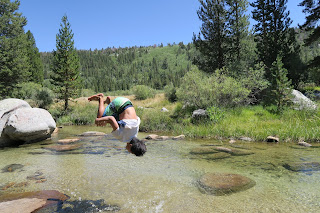
Last Friday I had the privilege of attending a tour of Jet Propulsion Laboratory (JPL) by way of The California Institute of Technology (Cal Tech). I'm a science lover. Apparently it's not a big secret because I received the invitation to tour from my step uncle, Phil Neches. I was ecstatic.
The tour began in an auditorium that was lined with models of space probes that had come out of JPL; Voyager, The probe that became our very first eyes on the other planets in our solar system and the first human-made object to leave the system altogether.
 |
| to-scale model of Voyager |
Voyager has taken pictures like this one: Revealing to us the smallness of our little planet and its moon.
There was a model of Cassini, the probe sent to study Saturn, its rings and moons.
 |
| 1/3rd scale model of Cassini |
That little dot with the arrow is Earth.
There was a model of Juno, a more recent deployment, launched August 5, 2011 and successfully arrived at Jupiter this July 4th.
 |
| 1/6th scale model of Juno |
While looking through an observation deck overlooking the assembly bay for JPL spacecraft, I spoke with a scientist who is part of the Juno team. In 5 minutes, this woman described some of the mysteries the Juno mission hoped to solve. Jupiter is made up of mostly hydrogen, like a star, it also has some helium. The gravitational force of the mass of the planet is doing something crazy to all of that hydrogen. It appears that the force of gravity may be separating the protons of the hydrogen from the electrons, creating a huge amount of polarization- like a magnet. The planet also rotates VERY quickly- once every 10 or so hours, and it creates a sloshing of the electrons, thus creating an enormous magnetic field that bulges out past Jupiter almost to the orbit of Saturn.

We spent some time in the Earth Sciences building. JPL has created and monitors some of the most important scientific tools for studying things like weather, global temperatures, atmospheric carbon dioxide, oxygen and ozone. Not only have they created the instruments of science but they have made the data that is collected daily to be accessible to anyone with a computer.
go to:
eyes.nasa.gov to monitor global temperatures yourself. Don't take politicians' word for it, empower yourself with the unbiased readings of modern scientific instruments. It's all there. According to the readings I saw on Friday, we have globally reached the tipping point that will take us to a rapid end of the current ice age, meaning that the polar ice will melt and sea levels will rise. One of the satellites looks at terrestrial ice and water. The Earth Scientist who spoke to the tour group said that when the Greenland ice sheets melt, sea levels will rise 22 feet. This is a problem for humans, not for the planet.
 |
This is a plaque that shows the Earth-monitoring satellites in operation today.
Two of my favorite stops on the tour were a visit to the to-scale model of the mars rover, Curiosity, which was successfully delivered to the surface of Mars with zero% margin of error in August of 2012. Curiosity is so cool!!!

It's as heavy as a car and its fueled by plutonium because of problem of Mars dust collecting on solar panels. this rover has a drill and analysis tools that allow it to take clean rock samples and analyze them on the spot for their contents. This is how we now know for sure that Mars once contained both flowing water and pooled water. Based on the chemical analyses from Curiosity, all the same building blocks for life were present on Mars at the same time life evolved on Earth. The differing factor of why Earth is rich with life and Mars is seemingly barren has to do with the planet's size. Mars is about half the size of Earth. Both planets had molten cores (an inner pool of liquid metal and rock). Earth's core remains hot and liquid. Mars's core cooled pretty quickly, based on surface area to volume ratio, (after 3 billion years or so) and solidified, thereby ending the ability of the planet to have and hold a protective magnetosphere. Earth's magnetoshpere looks like this:

Without the protection of a magnetoshere, Mars's atmosphere became vulnerable to the solar bursts that our sun regularly emits. The planet dried up.
One of the final stops was to the historic Space Flights Operations Facility. MISSION CONTROL!!!!!
|
The room is the same one used to monitor the Apollo missions. The room is modern but still has the smell of residual cigarette smoke.
 |
| They actually allowed us to sit down in the seats that scientists use when conducting missions. |
 |
| Just in the next room, scientists were at work 24 hours a day, seven days a week monitoring the current spacecraft sending data back from out in the solar system. The woman in front of me was working with Jupiter on her monitor, perhaps a Juno scientist. |
What a fantastic adventure for me and an opportunity I will cherish. I promise to share what I learned with anyone interested.
Signing out now.
































